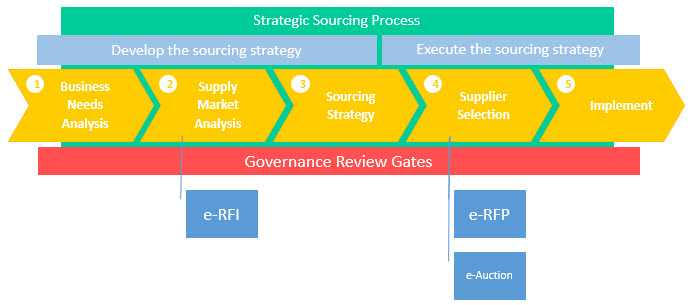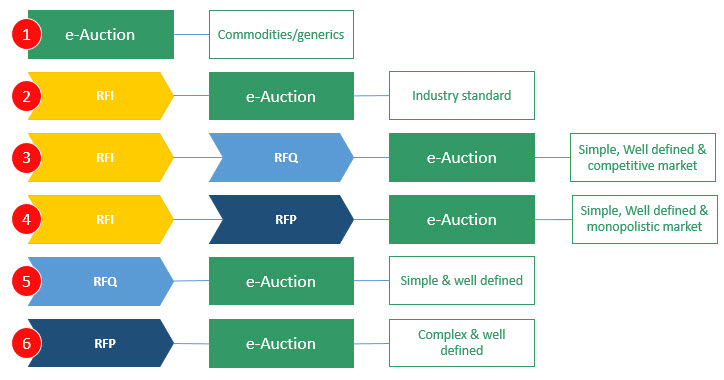Creating e-Sourcing Strategies for successful e-Auctions
Creating e-Sourcing Strategies for successful e-Auctions: We guide you the issues to assist procurement professionals work through the key issues in determining their e-Sourcing Strategy.
Compared to the actual running of the Event, picking a suitable category and how to engage the market can be one of the most challenging decisions.
Reverse auctions can be a highly effective addition to the strategic sourcing toolset when used correctly. They can be used to secure more competitive pricing, gaining increased understanding of supplier behavior and market dynamics, while compressing the overall sourcing process time.
Just like traditional sourcing it is important for both buyers and suppliers to have clear expectations from the process from the start. And to recognize that an e-auction is a tool to facilitate online negotiation as a part of the overall sourcing process.
As a proven market engagement tool, it is most successful when preceded by rigorous research and preparation, to define the sourcing strategy and prepare the sourcing documentation. It is important to evaluate the suitability of categories for e-sourcing and to remember that it is not a substitute for a rigorous strategic sourcing process.
Selecting your e-sourcing Strategy
The ideal category that is most suitable for an e-auction Event; is typically one that:
- has not been negotiated recently;
- has a high ratio of negotiable spend;
- have lots of verified participants;
- is defined down to the last minutiae of detail;
- is easy to put requirements together;
- is easy for supplier’s to quote on; and
- can be implemened quickly.
In other words a category that has savings potential, liquidity, definition and a simple schedule.
Most procurement professionals will be familiar with requirements, savings potential and schedule so below we shall focus on Liquidity.
2. Liquidity
Describes how attractive a category is for an e-Auction, the higher the liquidity score, the better. It is determined by considering the category complexity, the size of the spend, number of incubents, level of supplier interest, duration and resource requirements and savings potential:
2.1 Category complexity
Complexity describes how many product or service sub-categories are in the category included in the Event and is category specific. Ideally, sub-categories should be kept to single figures to avoid introducing too much complexity. The more complex an Event, the higher the barrier to supplier entry and the event documentation becomes more difficult to create.
2.2 Annual Spend
Greater than $400/£250k per annum is usually the requirement for a competitive e-Auction Event. A high value is more attractive to participants and will encourage more active bidding. A low value is less likely to. It is important to consider the typical size of the supply market players in relation to the value of your Event, e.g. You wouldn’t get US Steel or TATA bidding for your 1 Tonne structural steel contract.
2.3 Incumbents
Two or more is good, although one can have it’s advantages. With just one incumbent, they may be keen to retain business and defend it aggressively. However, two or more incumbents usually makes it easier to switch as they know your business already.
2.4 Supplier Interest
Three or more is usually the requirement. More participants equal’s more competition and typically more bids and better results. It is the buyers role to ensure a competitive Event by identifying suppliers and selecting the best candidates, but also ensuring they are all on a level playing field and bidding on the same terms.
2.5 Duration & Resources
2-4 weeks is typical with minimal resource. The longer and more resource-intensive an Event is, the less likely the participant will want to go through with it unless the opportunity is significant.
2.6 Savings Potential
What proportion of the spend on the category is negotiable?
Although a category may look to be valuable on the surface, when you investigate further and break down the value drivers, you may find that only a small percentage of the value is open to negotiation. In which case, is the category still of sufficient interest? Purchasing fuel would be an example, as at least 90% of the cost is outside the control of the suppliers. So you can only negotiate on the 10% of the value. Does this still give you the desired savings figures? Would the participants still be interested in competing online?
3. Stand alone or combining RFI, RFP & e-Auction
e-Sourcing can be conducted as a standalone process, following an RFI, following an RFP, or following both an RFI & RFP. The decision of which approach to take follows the careful analysis of spend, supply markets, and specifications, etc. Below we have produced a table to aid decision making:
Once all these factors are considered, then the buyer can determine the best market approach:
Creating e-Sourcing Strategies for successful e-Auctions
Succeeding with your e-sourcing initiatives requires, well defined category strategies. We have broken down the process into clear steps to guide you through the process. All you need to do to plan and execute them carefully and cover all the issues – to realize savings that will get you noticed.
Nuff said…
Contact us to learn more about our e-Sourcing products & services





